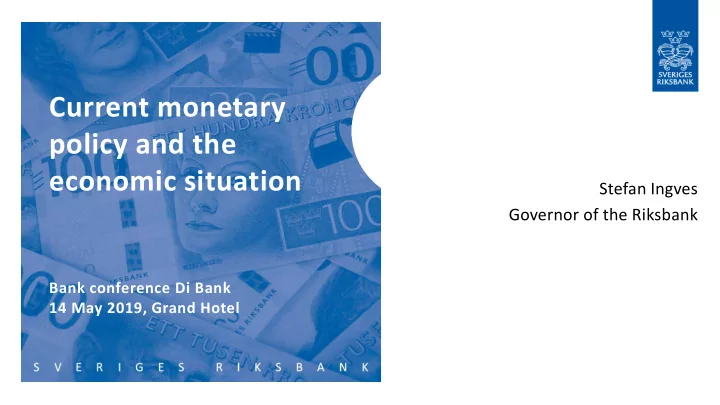

Current monetary policy and the economic situation Stefan Ingves Governor of the Riksbank Bank conference Di Bank 14 May 2019, Grand Hotel
Strong economic activity but slightly weaker inflation Expansionary monetary policy providing support
Inflation close to target Annual percentage change. Sources: Statistics Sweden and the Riksbank The broken line refers to the inflation target at 2 per cent.
Monetary policy needs to be forward-looking and be designed according to the prospects
Good economic activity abroad Index, 2007Q1=100. Sources: : Bureau of Economic Analysis, Eurostat, Office for National Statistics and Statistics Sweden
Lower inflationary pressures abroad Annual percentage change. Sources: ECB, Eurostat and the Riksbank
Continued strong economic activity in Sweden Unexpectedly rapid GDP growth towards the end of the year Economic activity as expected in a calmer phase Continued high pressure on the labour market Blue broken lines refer to average between 1996 and the latest outcome. Source: The National Institute of Economic Research
The Riksbank’s Business Survey “Surprising that economic activity is holding up so well”
The krona has weakened but is expected to strengthen going forward Weaker Krona Stronger Krona Index, 18 November 1992 = 100. Outcomes are daily data and forecasts refer to Sources: National sources and the Riksbank quarterly averages. The KIX (krona index) is a weighted average of the krona exchange rate against currencies in countries that are important for Sweden's international transactions. Blue broken lines refer to the historical average.
The krona has weakened but is expected to strengthen going forward Weaker Krona Stronger Krona Index, 18 November 1992 = 100. Outcomes are daily data and forecasts refer to Sources: National sources and the Riksbank quarterly averages. The KIX (krona index) is a weighted average of the krona exchange rate against currencies in countries that are important for Sweden's international transactions.
Conditions for on-target inflation Continued demand pressures in the Swedish economy Rising food prices and higher rent increases Previous krona depreciation Inflation expectations at 2 per cent Gradually rising inflationary pressures abroad
For inflation to remain close to target in the period ahead Repo rate to be raised at a slow pace Continued bond purchases 80 80 60 60 40 40 20 20 0 0 Per cent and nominal amount, SEK billion. Source: The Riksbank
Rising housing prices have led to an unsustainable increase in household debt • Problems have existed for a long time – vulnerabilities have increased • Housing market is dysfunctional for several reasons • Tax policy • Housing policy • Insider/outsider problems • All borrowers need to be affected by measures, not just new borrowers Total household debt as a share of disposable household income added together over the last four quarters. Percentage of annual disposable income. Sources: Statistics Sweden and the Riksbank
Current housing policy benefits certain groups • Housing policy is redistributive • Homeowners can make rapid “housing careers” – insiders • Several groups are outside the market and cannot benefit from this development – outsiders
Problems on the housing market need to be managed • Household debt constitutes a risk • Macroprudential policy measures have made a positive contribution • Housing price growth has slowed • Households take out smaller loans in relation to their income • But important that taxation and housing policies manage the imbalances between supply and demand on the housing market
Swedish banks are exposed to the property market Rising exposures to the property sector • The banking system is exposed to the property sector • Dependent on wholesale funding • Large, concentrated and interconnected 2005 2018 Source: Statistics Sweden The four major banks’ total lending to Swedish non-financial corporations and households, percentage of loans against collateral in property.
Thank you!
Recommend
More recommend